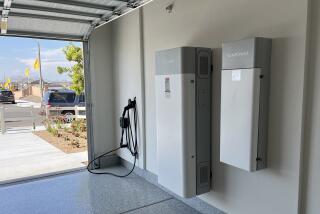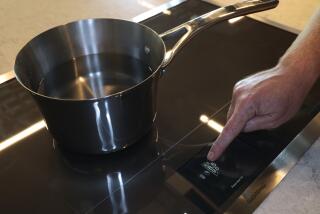Devices Can Shed Light on Energy Crisis
- Share via
It’s always been wise to conserve electricity, but California’s energy crisis has brought the issue to the forefront. Some have blamed the proliferation of PCs and other high-tech devices as part of the problem. That may be true, but PCs also can be part of the solution by helping control household lights and appliances.
X10 Inc. (https://www.x10.com) of Seattle manufactures lamp and appliance modules that ensure electrical devices are on only when you need them. And, lest you fear you have to use energy to save energy, the PC doesn’t have to be on for X10 to control appliances.
The X10 system takes advantage of the fact that home electrical wires can carry data as well as electricity. X10 controllers communicate directly with special switches and wall plugs to turn lights and appliances on and off and to dim lights through existing home wiring.
The system requires a controller along with a separate module or wall switch for each lamp and appliance you wish to control. Lamp and appliance modules typically cost between $15 and $20. X10 wall switches are designed to replace standard switches without any modifications to your wiring or walls. Kits that include a PC controller and some modules start at less than $40.
There are a number of ways to control devices both with and without a PC. One kit, called the FireCracker Ultimate Home Control kit--$50, now on sale for $40--features a small “FireCracker” interface that plugs into the PC serial port with a pass-through socket that also can accommodate a modem or other serial device. The kit also comes with one lamp module and a required “wireless link module” that transmits signals to electrical devices.
The problem with FireCracker is that it requires the PC to be on all the time, which is a waste of energy in itself. Fortunately, X10 has a better solution.
The $50 ActiveHome Kit plugs into the PC’s serial port only when the system needs to be programmed. Once the software has run, the controller can be disconnected from the PC and plugged into any electrical outlet. From then on, the controller stores the data so the PC doesn’t have to be on.
In addition to turning lights on and off, X10 products also can dim them. Instead of having the porch light at 100% power, you can dim it to 50% or 25% so it uses less juice. The system also includes a security feature that turns lights on and off at irregular intervals to give the house a lived-in look while you’re away.
The ActiveHome kit comes with a key-chain remote that can turn on lights inside the house from outside. And its SuperRemote can control TVs, VCRs and cable boxes.
The PC controller manages individual appliances or even multiple devices with the help of programmable macros. It’s possible, for example, to create a scenario that turns off most lights, sets other lights to go on and off at seemingly random times and even turns radios and TVs on and off to make it seem as if people are in the house. These events can occur at predetermined times or by pressing a button on an X10 remote control.
I’ve used various generations of X10 modules and PC controllers in two houses, and I’m generally pleased with them. The software that comes with the PC controller takes a few minutes to figure out, but it is relatively easy and allows users to create many scenarios and save them to disk.
Another energy-saving X10 device is the Hawkeye II Motion Sensor, which turns lights on when you enter a room and off a few minutes after there is no motion in the room. For a full list of X10 energy-saving products, visit https://www.x10.com/energy.htm.
More energy links can be found on the Web at https://www.wiredfamilies.com/electric.htm.
*
Technology reports by Lawrence J. Magid can be heard between 2 and 3 p.m. weekdays on the KNX-AM (1070) Technology Hour.






